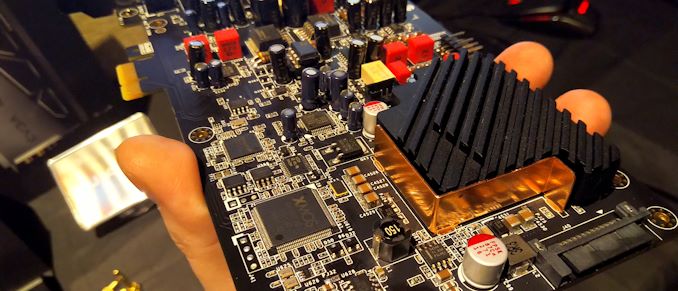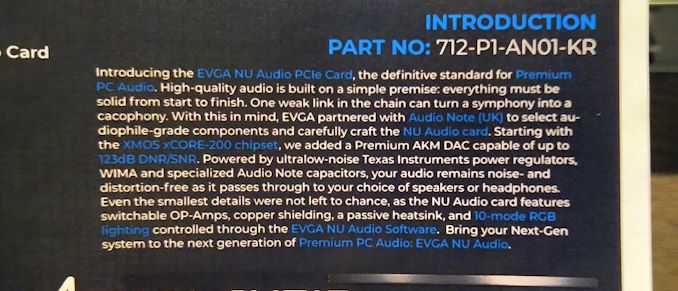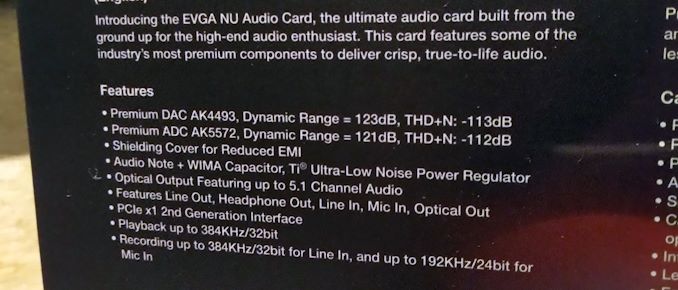EVGA Launches Its First Audio Card, the Nu Audio
by Ian Cutress & Anton Shilov on January 22, 2019 1:00 PM EST- Posted in
- Audio
- EVGA
- Trade Shows
- NU Audio
- CES 2019
- Audio Note

EVGA currently sells a range of products: motherboards, graphics cards, power supplies, cases, and laptops. EVGA has been expanding to other markets for a number of years now, and at CES 2016 we saw the beginnings of a USB audio device due to a collaboration with a professional company called Audio Note. We were impressed at the time, but since then we've not heard much about the project, and had kind of assumed it had been abandoned. But at CES 2019 EVGA introduced the results of the collaboration: its first audio card. This card uses a PCIe to USB controller, making it an internal USB audio product.
EVGA’s Nu Audio card was designed by Audio Note, a UK-based company that develops custom audio solutions. The PCIe 2.0 x1 card implements a PCIe to USB controller to the hardware, and is based on the XMOS xCORE-200 DSP accompanied by Asahi Kasei Microdevices’ (AKM) AK4493 DAC, the AKM AK5572 ADC, and the Cirrus Logic CS5346 ADC. The board uses a silver and gold-plated multilayer PCB with isolated dual ground planes for analogue and digital circuits. Being aimed at users who want a cleaner sound but also better sound support out of their audio outputs, the Nu Audio card uses audio-grade capacitors and resistors that carry Audio Note, Nichicon, WIMA, and Panasonic brands. Besides, it features switchable OP amps as well as a dedicated Maxim amp for headphone volume control.
The Nu Audio card is equipped with two RCA line outs for left and right speakers that can output 384 KHz at 32-bit audio, one output for headphones featuring impedance between 16 and 600 Ohms, an S/PDIF out, a line in supporting 384 KHz at 32-bit audio, and a mic in supporting 192 KHz at 24-bit audio. In addition to traditional analogue and digital outputs, the card supports USB audio class 2.0 enabled by the ASMedia ASM1042 PCIe-to-USB bridge. Meanwhile, to ensure that the board gets enough power, it has a SATA power connector coupled with a multi-stage VRM.
Since EVGA usually targets enthusiasts, its audio card is not only outfitted with a cooling system for heating components, but it is covered by a shroud featuring 10-mode RGB lighting as well as four Audio Reactive Lighting options that match the board’s lighting and audio. The bundled software allows for full EQ tuning, as well as a dynamic response implementation. With the right software, the audio card can support full audiophile formats, such as DSD, and switch between them as required.
EVGA is now currently selling the card, at a price of $249. This is the first in a line of cards, we were told - depending on the feedback of the hardware, the collaboration with Audio Note might extend into a gaming focused design or a more professional audio input/output design.
Related Reading
- EVGA Launches B360 Micro Gaming: Its First Budget Motherboard
- EVGA Releases CLC120 CL11 AIO CPU Cooler: Simple and Affordable
- EVGA Launches SC17 1080 Laptop: Core i7-7820HK, GeForce GTX 1080, TB3
- EVGA Torq X10 Gaming Mouse Review
Source: EVGA
















83 Comments
View All Comments
p1esk - Tuesday, January 22, 2019 - link
Ask a friend to do a blind test with you, and you will realize that you can't tell the difference between onboard audio and the most expensive card. Pretty much the only thing you can do to improve your audio experience is to buy better speakers.rocky12345 - Tuesday, January 22, 2019 - link
Not to sure about that it is pretty easy to tell the difference between onboard and a full sound card. the first thing you will notice is background noise form other parts on the main board it might be very faint but it is there on most onboard sound setups. Besides that my friend might not notice the difference but I know I sure would.I guess if you had just average speakers you might not notice because well the speakers are masking the lower quality audio form the onboard sound because they are not able to reproduce some of the audio spectrum the sound card is feeding to them. A high quality set of speakers will show the difference right away.
Samus - Tuesday, January 22, 2019 - link
It all depends what you seek in your audio. If you simply want a card where you can customize how the card processes sound, a $50 Xonar allows you to swap OPAMPS, and would be adequate for most people who don't need a ultra-fancy DAC.Where I'm at a loss is this card is essentially just a USB DAC. You can get a equivilent AK4493-based USB DAC (without swapable OPAMP) for $75 bucks. This will lack a decent 600ohm preAMP for headphones, though, so it really depends what your application is.
mode_13h - Wednesday, January 23, 2019 - link
Meh, swapping opamps feels like a gimmick, to me. Could the noise introduced by having socketed op-amps possibly outweigh the potential improvement gained over whatever they could afford to ship in the device?Dubbo07 - Wednesday, January 23, 2019 - link
It is as gimmicky as switching out a 8700k to a 9700k cpu.mode_13h - Wednesday, January 23, 2019 - link
LOL, but I don't buy it. I'd want to see the performance of the socketed version quantified and compared to soldered, first.mode_13h - Tuesday, January 22, 2019 - link
This is BS. It totally depends on the motherboard. On my Supermicro workstation board, the analog output has atrocious noise and cross-talk. It was clearly included merely for casual use with cheap desktop speakers.Fortunately, it's also got an optical output.
Protip: make sure to mute *all* inputs. I mean: telephone, mic, CD (analog), line-in, etc. If there's noise when you aren't listening to anything and crank up the volume, this is the likely culprit.
haukionkannel - Wednesday, January 23, 2019 - link
Well there is difference, but you need good headphones to hear the difference and most motherboard based audio systems can not drive high quality headphones...If you use grap 50$ headphones... it does matter what sound system you use... even mp3 Sounds almost same as falck. But if you have 1000$ audiphile headphones you definitely hear the difference between mp3 and falck and good external dac vs onboard sound... well if the sound board can delivery sound to those headphones in anyway...
nevcairiel - Tuesday, January 22, 2019 - link
You obviously have never used a professional-grade USB DAC, you seem to think those are limited to cheap USB headphones.mode_13h - Wednesday, January 23, 2019 - link
Lol, you've got to use AES/EBU or glass ST optical, or else it's not "professional".:)